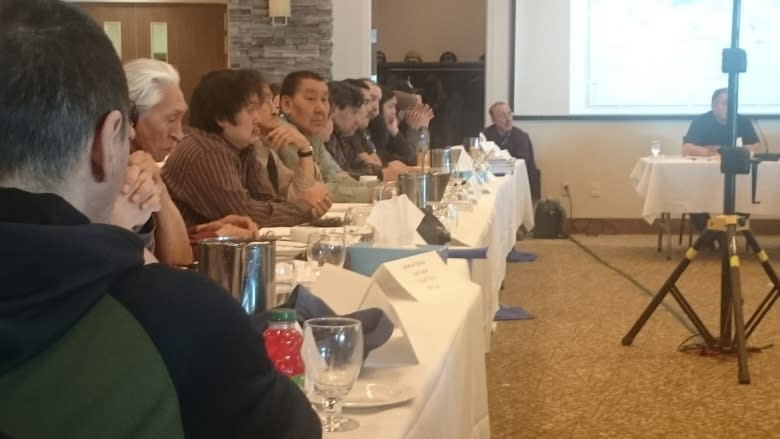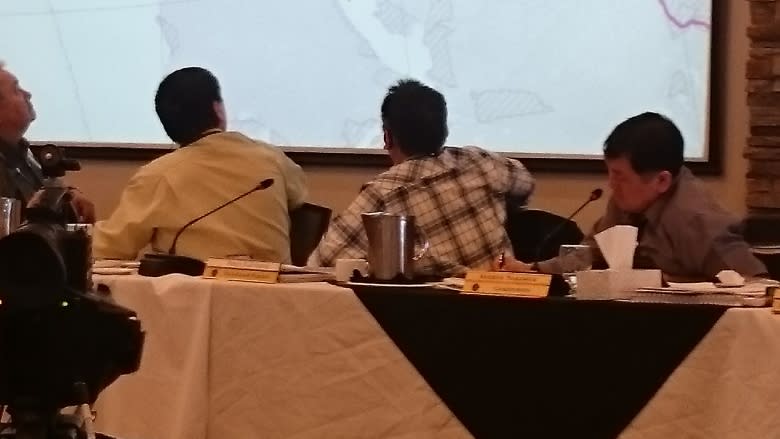Communities struggle to provide input on Nunavut's land use plan, says Iqaluit mayor
Concerns about whether communities have the capacity to contribute to wide regional plans were repeatedly raised during the final public hearings on Nunavut's land use plan.
Iqaluit's mayor Madeleine Redfern made this a focus of her presentation to the Nunavut Planning Commission, noting that the city has sent many letters saying they are unable to submit a plan without more help.
"Many municipalities did not do submissions for this hearing, simply because they don't have the resources or the expertise to take that on," she told CBC News.
Iqaluit does have a city planner, but Redfern says staff are too busy managing the city's internal development to look outward across all of the South Baffin region and consider all potential future development.
"We would love to see a hydro plant, but the fact is it's not going to be a city hydro plant," she said.
"Since it's not our infrastructure and likely won't be within our municipal boundaries, who's supposed to identify that and bring it forward?"
The Nunavut Planning Commission has been consulting with communities on the land use plan for around a decade. The creation of Nunavut's land use plan is mandated as part of the land claims agreement and work on it started before Nunavut was a territory.
The hearings held from March 22-26 in Iqaluit focused on the Qikiqtaaluk region. There will be hearings in the Kivalliq region in June and the Kitikmeot region in October.
The communities were joined by voices from industry, Inuit associations, and government, all commenting on the third draft of the plan, which was completed in 2016.
More consultations?
President of the Qikiqtani Inuit Association P.J. Akeeagok said in his presentation to the planning commission that he wanted the draft to go back to communities for further consultations.
For the plan to accurately represent the communities' priorities, he said he wanted them to understand that their input could be more than "do you like this protected area, yes or no?"
Brian Fleming, executive director of the Nunavut Association of Municipalities, agreed.
He said he thought the commission should send its planners to communities to help manage municipal plans because the hamlets were "shoestring operations," unable to manage surveying on their own.
He said secondary water sources, quarry sites, and remedial waste sites that fall outside of the municipal boundaries might not be included in the current draft.
Governments caution against over-protecting
Protected and special management areas were the two land classifications that received the most attention at the hearings.
Defining land as a 'protected' would bar any kind of development for the sake of protecting wildlife or popular routes travelled between communities. But since development can mean anything from mining to road building, the governments of Canada and Nunavut made the case for fewer protected areas and more special management areas.
Special management allows for case by case protections, such as a seasonal ban on work during caribou calving season or a stop-work order if a certain number of animals are spotted in the vicinity.
The Government of Nunavut said 17 per cent of the territory is already protected through parks and conservation areas and that it would like to see land protected via legislation rather than the land use plan.
Deputy minister for the environment David Akeeagok said the definition of "protected" needs to be clearer if the government were going to take the land use plan route, since banning development in caribou calving areas could mean a road connecting Nunavut to the rest of Canada would never be built.
While caribou calving grounds were discussed, the Qikiqtaaluk communities were more interested in marine wildlife, with cruise ships and icebreaking being major concerns.
The commissioners will weigh everyone's opinions and edit the document, which will be sent to the federal and territorial governments and Nunavut Tunngavik Incorporated for review and sign off.
"Hopefully it will be workable for everybody, of course it may not be that way because we have different opinions," said James Eetoolook, vice-president of NTI.
"People are saying industry should take place and also there's people who need to survive on wildlife because of the high cost of living up here in the North."
The final plan is expected in 2018, with a requirement for it to be reviewed every five years to adjust for changes in climate, knowledge and priorities.





